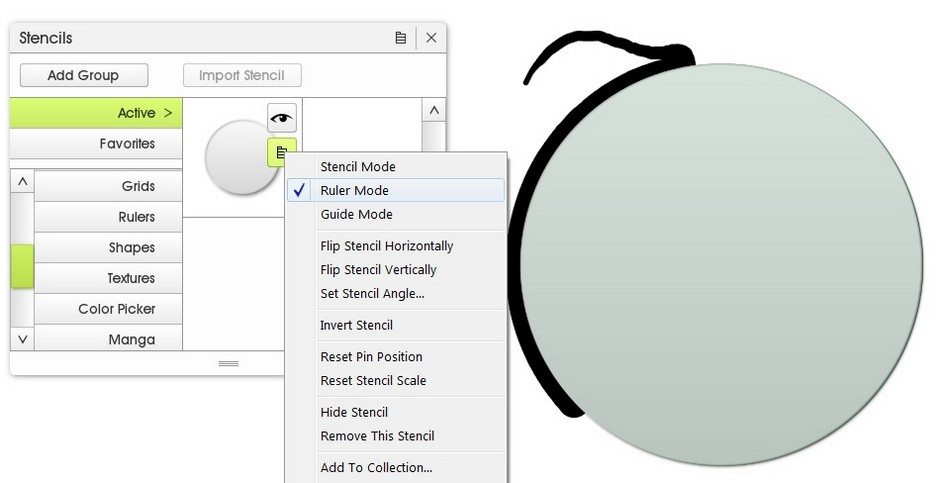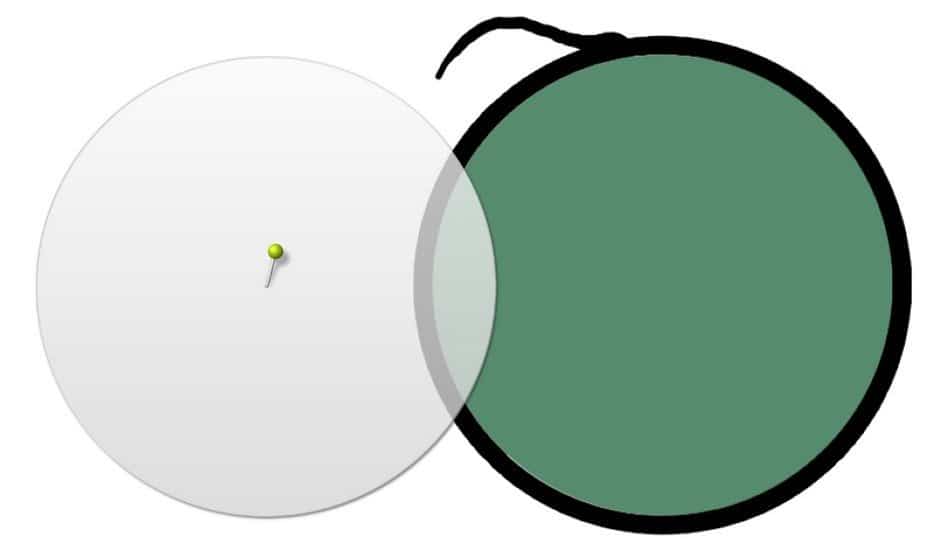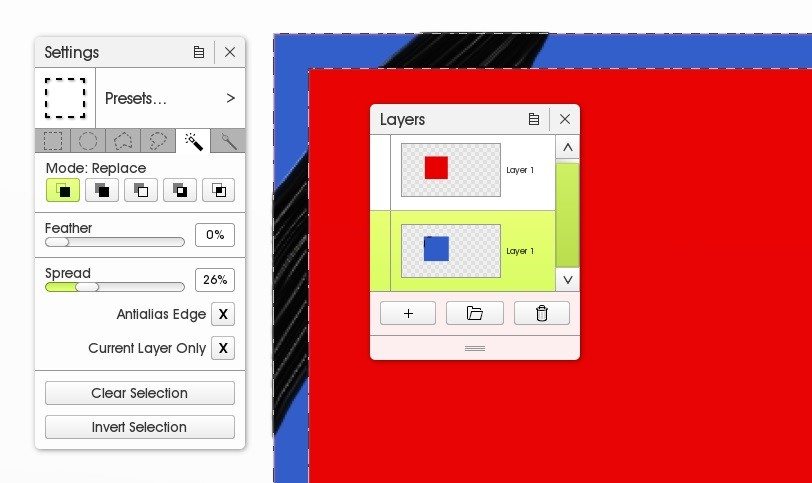How to Outline a Distinct Shape in Clip Art
How to Describe An Outline Around A Shape in ArtRage
Learn how to draw a neat border around an area of pigment!
While Stencils are commonly the about effective for complicated shapes and manus fatigued border effects, you tin can besides apply Selection tools and a few other tricks to get exactly the outline that you need. This guide covers several dissimilar methods for creating and editing a edge, just y'all can mix and lucifer them to suit your personal workflow and the needs of your specific moving-picture show.
This guide assumes that you are using ArtRage 5, with all tools and features available, merely any edition of ArtRage with layers will allow y'all to use some of these methods.
On This Page:
- Add a border circular the unabridged canvas
- Add a edge around an expanse of paint
- Depict Straight Lines By Hand
- Duplicate and Transform
- Stencils
- Selections
- Edit the appearance of the border
- Lock Transparency
- Make full Tool
- Stencils
- Selections
one. Adding a Border Around Your Painting
If y'all simply want to add a border as a frame around your work, or separate your canvas up into panels, then that is easy to exercise by using the Grids, Guides and other limerick and straight line features.
If you lot just want to add a bleed expanse for printing, simply expand your canvas size after you have finished painting. If you lot are on a mobile app and practice not have access to the desktop version of ArtRage, create a single layer version of your image and utilise Transform to shrink it slightly within the canvas.
two. Adding a Border Effectually an Area of Paint (Outlining A Shape On A Layer)
There are several ways to draw a nifty edge around a shape that you accept painted in ArtRage. If you want to add a border around i area of pigment on your canvas, then you tin can use stencils, transform, layers, and selection tools.
Depict Straight Lines by Paw
If y'all want to add together a uncomplicated square border, or a few straight edges, around your shape, so this is very like shooting fish in a barrel. You can plan out your border using Guides and Grids and use the 'Snap to Grid' feature to depict outlines. Yous tin can also manually position the Ruler stencil or employ the Ctrl (/Cmd) or Ctrl + Shift control to describe perfectly direct lines anywhere on the sheet. See How To Draw Straight Lines for a consummate explanation of the different options.
Duplicate and Transform
This is often the simplest method and can be used in almost any edition of ArtRage, even the mobile apps (both the full iPad and Android apps allow you lot to employ multiple layers and transform a layer).
If you accept a very symmetrical shape (e.g. a circle or foursquare), so the easiest fashion to create a edge is but to indistinguishable that shape on a new layer and use transform to expand or shrink it. You will then have two shapes, one slightly larger than the other.
Duplicate your image. Change the color of the edge layer and so that it is clearly visible. 
Ways to quickly change the colour of a layer
You lot can chop-chop and easily edit the appearance of paint on a layer past using:
- The Fill tool. I click and you're washed!
- The Choice tool to select the pigment area and and then repaint the selected surface area.
- Lock Transparency manner (in the Layers menu) which will let you repaint only the existing pigment on a layer.
- 'Adjust Layer Colors' under Edit > Filters (Ctrl + J) which will let you quickly suit the color and contrast of a layer.
Use the Transform tool to increase the size of the layer so that it create a visible edge backside your original layer. 
Yous then have a quick and easy edge effectually your paint! You lot can merge the layers together, or continue editing the appearance of the border using some of the more advanced tips farther down. 
If you do not accept a symmetrical shape, then yous can notwithstanding use this method, but the 2d shape volition not calibration perfectly around the get-go shape. You may accept to adjust it further past hand, or utilise a Stencil instead.
Using Stencils to Create a Border
Stencils are frequently the easiest way to add a border, especially if you accept a complicated shape. Stencils mask out areas of paint and can be transformed and saved. They are available in all desktop editions, merely the Ruler mode is not bachelor in ArtRage Low-cal.
Interacting with Stencils
- Most of the menu options for stencils are bachelor by correct clicking on the stencil or from the card button side by side to the stencil in the 'Active' section of the Stencils panel.
Note: If you are using Mac OSX, you can right click by holding the Control key on your keyboard.
You can use the Transform tool to edit your stencil (move, flip, resize, rotate) or yous can employ keyboard shortcuts.
Motion the stencil effectually by right clicking and dragging, or belongings the Space Bar and clicking normally.
Resize: Ctrl (Cmd) + click and drag left or right
Rotate: Alt + click and elevate left or right
Creating a Border With Stencils
If you lot want to create a very simple shape such as a circle, then yous tin use existing stencils or the selection tool to define the expanse before adding paint. This besides lets you jump alee a little when information technology comes to creating a border! However, if you are painting a shape from scratch, it can be every bit uncomplicated or complicated as you like, and these steps will work.
After you have created your shape, create a stencil out of it. To turn it into a stencil, go to the layers options to 'Create Stencil From Layer Contents', or export that image every bit a black and white shape and then open up Stencils and import it as a new stencil.
Note: If your shape is non solid (it has semi-transparent areas), and so the stencil volition not be completely opaque and will allow you to paint into the translucent areas. Every bit long every bit the edges are solid, then y'all tin avoid the translucent areas. 
You lot can add a new layer backside your paint to work on if y'all wish, or keep working on the same layer. It will be easier to edit the border later if information technology is on a different layer, but you lot may not need whatsoever actress steps. While it helps to know what you want before you lot actually add whatever paint, you tin merge layers later on, or select and move your border using the tips at the cease if y'all need to move information technology to a different layer afterwards.
Position the stencil over your paint if y'all imported it (it will automatically appear exactly over your paint if you turned that layer into a stencil). 
Now simply right click on it (or employ the bill of fare in the Active Stencils department of the Stencils panel) and cull 'Invert Stencil'. This volition block out the expanse you painted, and let you paint around it instead.

You lot can now pigment a border around your stencil, merely it may not be very neat! If you demand a very even border, you lot need to set the Stencil to Ruler Mode. Right click on it again (or go back to the carte du jour in the Stencils panel) and select 'Ruler Mode'. 
You can now draw neatly around the border of the stencil. Your line volition keep around the edge of the shape even when your cursor moves over the stencil itself. You can still paint freely on the canvas away from the stencil so try and only draw over the stencil if y'all demand a perfect outline. 
You lot can also use stencils with more complicated shapes!

Using the Option Tool to Create Borders
Selections are a footling more complicated and cannot be saved and reused like Stencils, but they are frequently very quick to utilise (particularly with keyboard shortcuts) and let you edit your selection to become precisely the result you want.
Stencils work for any shape, and are the all-time style to draw a neat outline around a complicated shape that isn't symmetrical or doesn't have straight edges.
Useful Keyboard Shortcuts:
Switch to the Option tool: Shift + T
Invert active selection: Ctrl (Cmd) + Shift + I
Clear all agile selections: Ctrl (Cmd) + D
Move active selection: Click and elevate within the active selection Constrain choice aspect ratio (go a perfect square or circle): Hold Ctrl (Cmd) + Shift while drawing the option.
Create an outlined area of paint using selections by:
- Depict the agile pick around your paint (where y'all want the border to go), using whichever selection shape works best.
- Switch to Magic Wand and Subtraction mode in the tool settings (see screenshot: Magic Wand is in the tab forth the top, Subtraction mode is the third button along in the little row of squares).
- Select the expanse inside the border. This volition deselect that area (subtract it from the active selection) and leave you with an active pick on the edge.
- Important: The 'Magic Wand' may go out unselected edges if there is whatever antialiasing (semi-transparent pixels to soften the edge). Adapt Spread upwardly to cancel this out and select exactly the area you need.
Annotation: You can also do this the other manner around by selecting the inside first and then drawing the outside edge using Divergence fashion. This will only leave an agile selection in the areas that did non have an existing selection.


You tin can also combine stencils with selections by selecting effectually or inside the area masked by the stencil. For example, y'all can create a perfect square or circle around your existing square or circle, and drag the selection into the correct position. Y'all can also switch to 'Paint Area' mode and draw a line effectually the border of your stencil in Ruler or Guide mode. This will create an agile selection that is exactly the shape of the outline (note: it will overlap inside the stencil – like painting with a stencil in Guide mode, but it will be an even stroke).
3. Editing Your Border
You tin edit and repaint your border using stencils and selections to mask or select the border area. You tin also lock the transparent areas so that you can freely repaint the border. Most of these methods use the same techniques that y'all used to create the border, but for more ways to edit an expanse of paint, see this guide: How To Edit Paint Color.
Lock Transparency
If your edge is on its own layer, go to the layers carte and utilise the lock options to 'Lock Transparency'. This will lock all the transparent areas on that layer so that y'all tin can repaint the existing paint as much as you like. This is often a not bad deal simpler than trying to create the perfect selection or stencil. 
Color your border with the Fill Tool
You tin just use the Make full tool to flood your border with a new color. See the guide to the Solid Fill settings for help getting the perfect issue.
If you want to add a blueprint or slope, you volition need to create an active selection or use stencils to mask the residuum of the layer. Read the Pattern Fill guide for examples of how this works.
Moving the border to a split up layer
If you painted the outline on the aforementioned layer every bit the residual of the pigment and desire to edit it separately, you tin can do this in two ways.
- Duplicate the layer. Apply the original stencil (the one you drew around to create the edge) to mask the paint while y'all erase the border on i layer, then invert it on the other layer. This will mask the edge and leave the within exposed, then you can erase that and exit the edge on its own on a new layer.
- Set up the selection tool to 'Magic Wand' style and select the border. Cutting and paste it to a new layer.
- If you desire to become actually complicated (or your edge is a mix of colors and hard to select), you tin mask the surface area outside of the border with stencils and then switch the selection tool on 'Paint Expanse' style. This will follow the edge of the stencil in Ruler and Guide mode, simply stencils practice not prevent selections, and so the selected area will extend under the border of the stencil.
Tip: If you are having trouble selecting your edge area because it is not an even color, create a template layer that is a single solid colour. Use this to create stencil and selection shapes, then hide it and switch back to your main layer to create the border.
Editing with Stencils
If y'all have stencils masking the within and outside of the edge, and then y'all tin can easily repaint the border itself. If your original paint and edge are on the aforementioned layer, keep the offset stencil (that yous drew effectually) and add together a new stencil from the electric current layer contents. The new stencil will frame the exterior of the border, and the original stencil will mask the inside.
If your border is on a separate layer, and so just turn the border into a new stencil and invert the stencil.
Editing with Selections
Use the Magic Wand manner for the selection tool to select the area of the border. If your border extends behind other paint (for case, if you moved a duplicate layer backside your original paint), untick 'Current Layer But' to select based on all visible paint, not just the paint on 1 layer. 

gonzalezwhisterell1957.blogspot.com
Source: https://www.artrage.com/manuals/graphic-design/how-to-add-a-border-or-outline-around-paint/
0 Response to "How to Outline a Distinct Shape in Clip Art"
Post a Comment